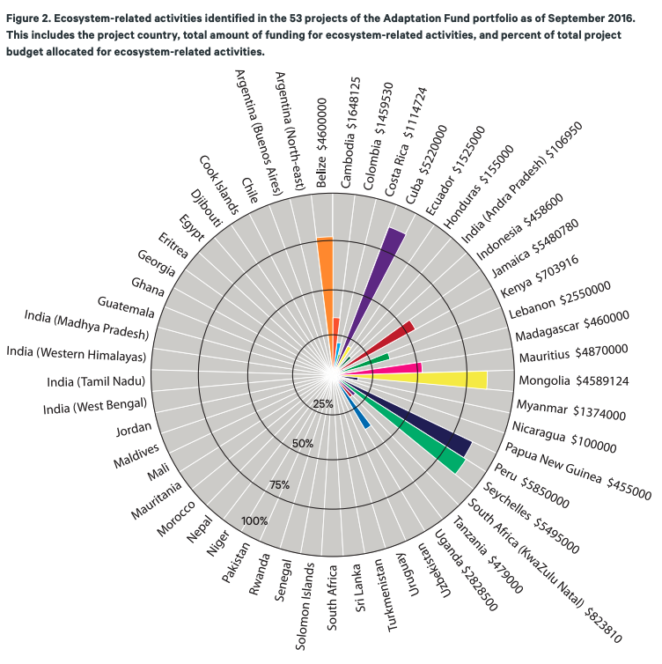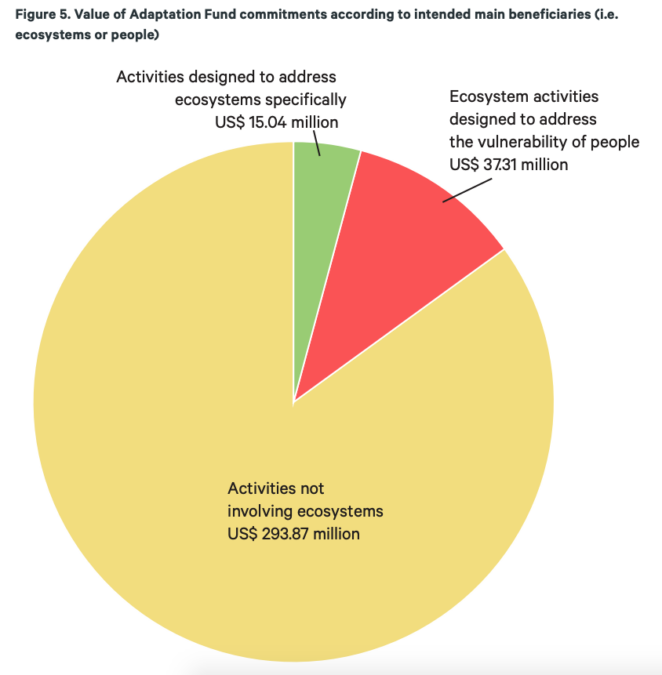Article /
Finance for the adaptation of ecosystems to climate change: a review of the Adaptation Fund portfolio

Introduction
This paper is interested in how much adaptation practitioners and funders focus on how other species adapt to climate change.
It examines one of the major international climate funds, the Adaptation Fund, and analyses the extent of funding that has been allocated for activities that address the needs of, and challenges faced by other species. It also examines how and whether funded activities respond to the priorities emphasised by conservation literature and assesses whether ecosystem resilience was the primary focus of the activities funded.
Findings

The authors found that very little of the activities supported by the Adaptation Fund are ecosystem-related activities – totalling only about 15% of its allocated funding (as of 2016). Of this, most activities focus on delivering specific ecosystem “services” for people – such as protection against flooding or coastal erosion – rather than for other species. Relatively few are designed primarily to protect ecosystems from current stresses like pollution. This likely diminishes any positive effects that projects are making towards ecological resilience.
Ecosystem Resilience:

Figure 5 shows the breakdown of funding across the whole Adaptation Fund portfolio, between (i) activities that are designed to address ecosystems specifically, (ii) activities that intervene in ecosystems but are designed mainly to deliver resilience outcomes for people or infrastructure, and (iii) activities that are not related to ecosystems. Just US$ 15 million, or 4% of the total Adaptation Fund portfolio, is designed primarily for ecosystem resilience. This amounts to less than one third of the ecosystem-related budgets.
The budget targeting ecosystem outcomes consists of the funding for projects in Belize, Peru and Mongolia. The Belize project aims to strengthen the climate resilience of coral reefs; improving ecological health is stressed as a key purpose of the overall project. The Peru project targets two marine ecosystems, and highlights climate (and other) risks to these, and their importance as fisheries. The Mongolia case is less clear but does specifically describe habitat restoration in its results framework.
Across the remaining projects with ecosystem-related activities, the focus – and hence choice of ecosystem and design of intervention – is on increasing resilience of vulnerable people rather than on specific ecological outcomes.
Exclusion:
Many project documents make at least passing references to benefits for ecosystems, but rather fewer actually describe and allocate funding for activities that might materially improve the health and resilience of ecosystems.
Outcomes and Impacts
The scale and quality of interventions that is classified in this paper as ecosystem-related appear highly questionable from the perspective of addressing the needs and vulnerabilities of other species.
Even though project documents often allude to ecosystem benefits, for the most part these are not reflected in monitoring and evaluation frameworks, leading to the conclusion that they are not important to the project’s purpose or logic.
Even among those projects that include ecosystem-related activities, most have not been designed with the resilience of ecosystems in mind.
Implications for climate funds and project developers:
These observations suggest that the vulnerabilities and adaptation needs of other species are not featuring prominently in the adaptation projects developing countries and project developers prioritise for international funding.
Furthermore, project proponents significantly overstating the contribution projects are making to ecosystems, suggesting potential benefits for other species that seem disconnected from the project activities and are rarely verified by project monitoring and evaluation (M&E) frameworks.
Conclusion
The paper concludes that ecosystem outcomes are of limited importance to almost all projects, even those projects that include some ecosystem-related activities. These findings raise serious questions about whether sufficient or meaningful attention and resourcing is given to how other species and natural ecosystems can adapt to climate change. Major investments are needed to turn this around, as is a change in how people prioritise other species in their pursuit of social and economic development.
Suggested Citation
Atteridge, A. and Tenggren, S. (2019). Finance for the adaptation of ecosystems to climate change: a review of the Adaptation Fund portfolio. SEI working paper. Stockholm Environment Institute, Stockholm, Sweden.
